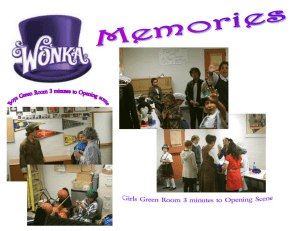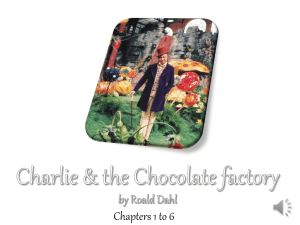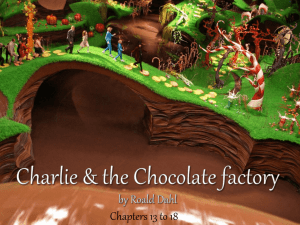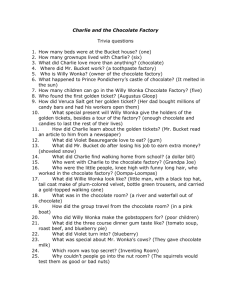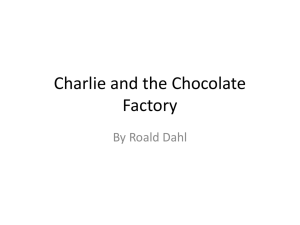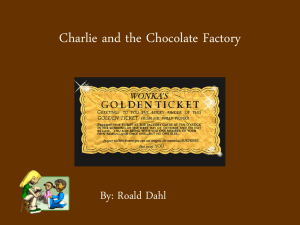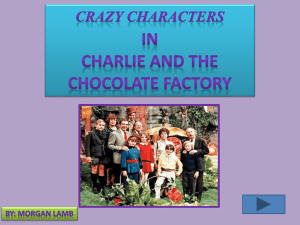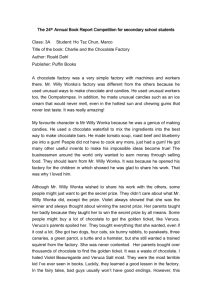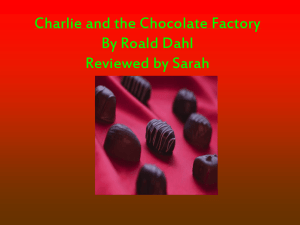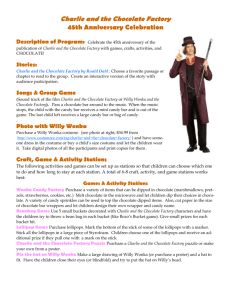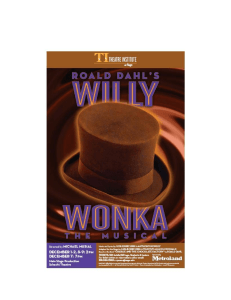William and Mary Navigator Charlie and the Chocolate Factory
advertisement
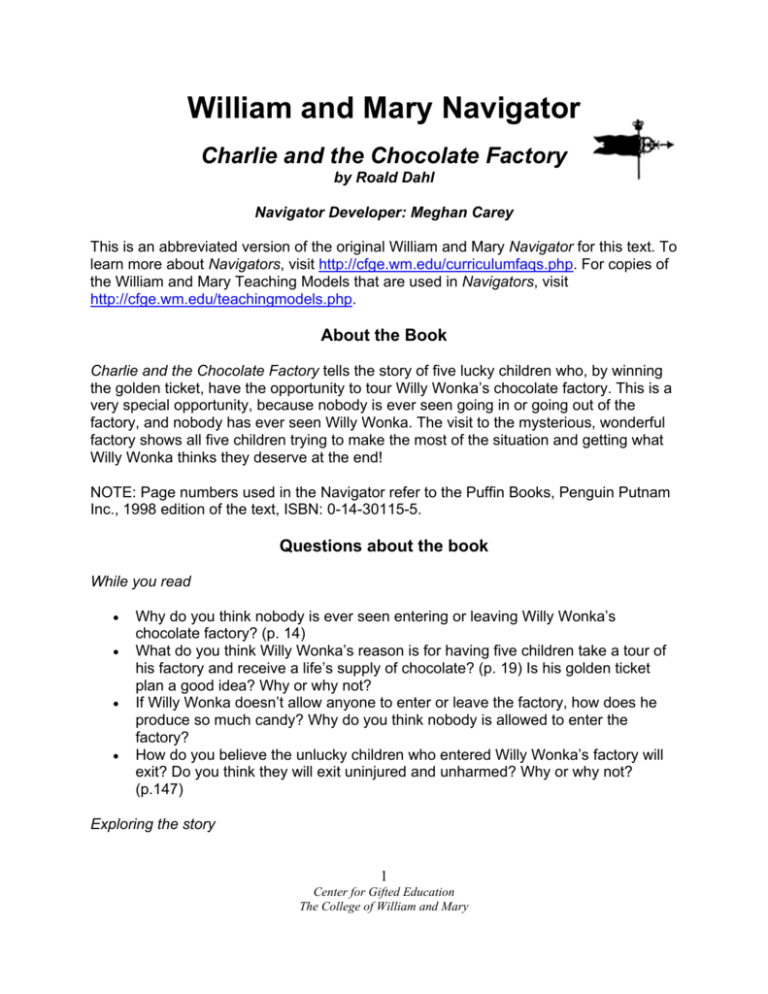
William and Mary Navigator Charlie and the Chocolate Factory by Roald Dahl Navigator Developer: Meghan Carey This is an abbreviated version of the original William and Mary Navigator for this text. To learn more about Navigators, visit http://cfge.wm.edu/curriculumfaqs.php. For copies of the William and Mary Teaching Models that are used in Navigators, visit http://cfge.wm.edu/teachingmodels.php. About the Book Charlie and the Chocolate Factory tells the story of five lucky children who, by winning the golden ticket, have the opportunity to tour Willy Wonka’s chocolate factory. This is a very special opportunity, because nobody is ever seen going in or going out of the factory, and nobody has ever seen Willy Wonka. The visit to the mysterious, wonderful factory shows all five children trying to make the most of the situation and getting what Willy Wonka thinks they deserve at the end! NOTE: Page numbers used in the Navigator refer to the Puffin Books, Penguin Putnam Inc., 1998 edition of the text, ISBN: 0-14-30115-5. Questions about the book While you read • • • • Why do you think nobody is ever seen entering or leaving Willy Wonka’s chocolate factory? (p. 14) What do you think Willy Wonka’s reason is for having five children take a tour of his factory and receive a life’s supply of chocolate? (p. 19) Is his golden ticket plan a good idea? Why or why not? If Willy Wonka doesn’t allow anyone to enter or leave the factory, how does he produce so much candy? Why do you think nobody is allowed to enter the factory? How do you believe the unlucky children who entered Willy Wonka’s factory will exit? Do you think they will exit uninjured and unharmed? Why or why not? (p.147) Exploring the story 1 Center for Gifted Education The College of William and Mary • • • How do you think Charlie Bucket feels towards other children who have an extraordinary amount of money and get as much chocolate as they want? Do you think he wants these children’s lives? Why? When do you think this story takes place? What evidence supports your inference? Throughout the book, how does Willy Wonka demonstrate his fondness for Charlie? Do you think his positive attitude towards Charlie is apparent to the other children? Why or why not? Meeting the characters • • • • • Explain the relationship Charlie has with his grandparents. How does he feel about them? How are his feelings different for different individuals, and why? How do Charlie’s parents positively influence his upbringing despite their lack of money? How does Charlie seem to feel about the way the other children are acting during the factory visit? How do you know? Why might Charlie be frustrated with the other children and their attitudes? How is Willy Wonka able to employ Oompa-Loompas in his factory? Do you think the Oompa-Loompas enjoy working and being paid in chocolate? Why or why not? Provide evidence from the story to support your answer. How would you describe Willy Wonka? Is he a good and caring person? Support your answer with specific details. Understanding the ideas • • • • What does the book demonstrate about the phrases, “good things come to those who wait” and “good things come in small packages”? Give specific examples from the book to support your answer. How is the concept of respect important in the story? How does Willy Wonka show his point of view on children’s respect for adults? Does this book prove that the phrase “money can’t buy happiness” is true? Why or why not? Discuss the criticisms people might have in today’s society about Willy Wonka’s actions. Bring in examples from the book of the ways he treats the children and the Oompa-Loompas. Connecting to you • At the beginning of the book, Charlie’s feelings about chocolate were described in this quote: “Many times a day, he would see other children taking creamy candy bars out of their pockets and munching them greedily; and that, of course, was pure torture.” (p. 6) In your life, has there ever been a time when you wanted something so badly it hurt? Describe your experience. 2 Center for Gifted Education The College of William and Mary • • • Have you known people who behave like some of the other children in the story? How do you handle your interactions with these people? In your own experience, would you agree with the statement, “We are a great deal luckier than we realize, we usually get what we want – or near enough”? (p.38) Why or why not? Explain your answer, using specific examples. In the end, Charlie goes beyond achieving his dream. Has there ever been a time in your life when you were about to give up but kept on trying really hard to achieve your dream? Describe your dream and how you tried to reach it. Did you succeed? Activities 1. Complete a Literature Web about the book. Fill in your responses to each of the bubbles using the questions as a guide. 2. Write a book review on the novel. In your review, state and explain your point of view about the quality of the novel and provide specific details about why you would or would not recommend this book to other students your age. Use the Hamburger Model as a guide, and follow the steps of the writing process to review and revise. 3. Choose one of the following quotations from the novel. Write a persuasive essay in which you discuss whether or not you agree with the ideas expressed, using examples from the novel, other books you have read, or your experience. Use the Hamburger Model as a guide for your writing, and follow the steps of the writing process to review and revise. • • • After entering a contest: “however small the chance might be of striking lucky, the chance was there.” (p.28) “Do all children behave like this nowadays-like these brats we’ve been hearing about?” (p. 34) “It [Television] rots the senses in the head! It kills the imagination dead! It clogs and clutters up the mind! It makes a child so dull and blind he can no longer understand a fantasy, a fairyland! His brain becomes as soft as cheese! His powers of thinking rust and freeze! He cannot think-he only sees!” (p.139) 3 Center for Gifted Education The College of William and Mary 4. Create a sixth character who will also win a golden ticket to enter Willy Wonka’s Chocolate Factory. How will this additional child find the golden ticket? What will be the misfortune preventing this child from successfully exiting the factory? You may choose to draw the child and her/his stories (in a format such as a comic strip or picture book), and/or you may compose a creative essay to describe the child. 5. The Oompa-Loompas sang a song for each one of the children who did not make it all the way through the factory. They did not sing a song about Charlie, though, because he made it to the end of the tour. Reread the songs about the other children, and then compose a song about Charlie that the Oompa-Loompas might sing for him. 6. Do a “word study” of one or more of the vocabulary words from the novel (listed below). Find out the definition of the word, synonyms and antonyms, and word stems and origin. Then find at least three other words that use one or more of your word’s stems, and create an example to explain your word (a sentence, an analogy, a visual representation, etc.) Use the Vocabulary Web to organize your responses. abide (p.63) belching (p.7) hovering (p. 150) colossal (p.12) ludicrous (p. 100) curranty (21) marvelous (p. 16) despicable (p.32) mischievous (p. 71) dotty (p.20) mounds (p. 110) dumfounded (p. 64) peals (p. 36) ferociously (p.31) rancid (p.117) gallantly (p. 121) repulsive (p.23) genius (p.19) revolting (p.23) hoard (p.35) sanatorium (p. 102) sensational (p. 94) sly (p.35) suction (p. 74) tense (p.28) trod (p. 134) vital (p. 37) warren (p. 62) wondrous (p. 140) wretched (p. 73) 7. Design a taste test for five of the chocolate candy bars sold in American convenience stores. Remember to write out a plan for your experiment, including your research questions and hypotheses. Conduct this experiment on a group of classmates, friends, and family and record your results. Calculate your results and represent your results using graphs. Identify any trends in your data with respect to who was able to identify which candy bars more easily AND who preferred the taste of which candy bars. For example, were the adults in your experiment able to identify one particular candy bar more easily than the children, or vice versa? Compose a summary research paper to report your results and conclusions. 8. One of the main foods this book focuses on is chocolate. Research the history of chocolate. How is it made? Where does it come from? How was it brought to the United States? Investigate the history of chocolate as it is connected to European and Native American interactions. Create a timeline representing these series of interactions. 4 Center for Gifted Education The College of William and Mary 9. The workers in Willy Wonka’s factory are called Oompa-Loompas. They perform all the work for Willy Wonka; however, he does not pay them. They work only for chocolate, not for money. Mr. Wonka brought them over from Loompaland, a terrible country. Explore the issue of having people perform work for which they are not being paid. Find out where slavery still occurs and trace its history in the United States. Write a position paper discussing how Willy Wonka’s actions toward the Oompa-Loompas are or are not acceptable. 10. Conduct a comparison study of the works of Dr. Seuss, another author of fictional children’s stories, and Roald Dahl. Review at least two or three Dr. Seuss books to help you support your comparisons, and read or skim at least one other book by Roald Dahl. What are some ways in which Dr. Seuss’s use of language and humor is similar to Roald Dahl’s? For example, both authors create their own words to describe characters such as Oompa-Loompas. Compare and contrast how the two authors make up characters and words to suit their needs. Based on your research, create interview questions you would ask these two authors if they were to appear on a news show you were hosting. Books and Internet sites For further reading – some other books by Roald Dahl The BFG Boy Charlie and the Great Glass Elevator James and the Giant Peach Matilda Roald Dahl’s Revolting Recipes The Witches The Wonderful Story of Henry Sugar and Six More For further reading – some other books you might enjoy Hershey; far-sighted confectioner, famous chocolate, fine community by Samuel Forry Hinkle TEE VEE Humphrey by John Lewellen Chocolate, an illustrated history by Marcia Morton Roald Dahl: A Biography by Jeremy TreGlown Charlotte’s Web by E.B. White Stuart Little by E.B. White Half Magic by Edward Eager 5 Center for Gifted Education The College of William and Mary Useful websites The Official Roald Dahl Website http://www.roalddahl.com/index3.htm The Official Website of The Willy Wonka Candy Factory http://www.wonka.com Learn all about Ghirardelli chocolates http://www.ghirardelli.com The M&Ms webpage http://global.mms.com/us/index.jsp Explore the science and history of chocolate http://www.exploratorium.edu/exploring/exploring_chocolate The History of Candy and Candy Trivia http://www.candyusa.org/History/candy.shtml The History of Chocolate http://www.fmnh.org/Chocolate/history.html Dr. Seuss and His Works http://www.seussville.com 18th and 19th Century Children’s Literature http://www.sc.edu/library/spcoll/kidlit/kidlit/kidlit1.html Merriam-Webster Dictionary www.m-w.com Glossary of Literary Terms www.virtualsalt.com/litterms.htm 6 Center for Gifted Education The College of William and Mary
